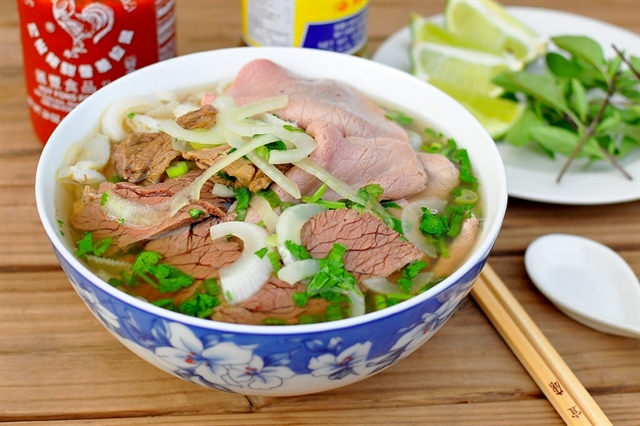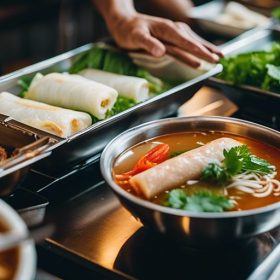Vietnamese cuisine is known for its fresh ingredients, bold flavors, and unique cooking techniques. One dish that has gained international recognition and popularity is pho, a traditional Vietnamese noodle soup. Pho has become a beloved dish around the world, with its flavorful broth, tender meat, and fragrant herbs and spices. In this blog post, we will explore the history, ingredients, and cultural significance of pho.
The Origins of Pho: A Brief History
Pho originated in northern Vietnam in the early 20th century. It was originally a street food sold by vendors who used leftover beef bones to make a flavorful broth. The dish gained popularity in Vietnam during the French colonial period when the French introduced beef into the Vietnamese diet. Pho eventually spread throughout the country and became a staple in Vietnamese cuisine.
The Meaning Behind the Name “Pho”
The origin of the word “pho” is unclear, but there are a few theories. One theory is that it comes from the French word “pot-au-feu,” which means “pot on the fire.” This theory suggests that pho was influenced by French cuisine during the colonial period. Another theory is that “pho” comes from the Vietnamese word “phở,” which means “to boil.” This theory suggests that pho was named after the cooking method used to make the dish.
The Traditional Ingredients of Pho
Pho typically consists of beef or chicken broth, rice noodles, and various herbs and spices. The broth is made by simmering beef or chicken bones with onions, ginger, and other aromatics for several hours. This slow cooking process allows the flavors to develop and creates a rich and flavorful broth. The dish is usually served with thinly sliced beef or chicken, bean sprouts, lime wedges, and chili peppers. Additional garnishes may include Thai basil, cilantro, and sliced onions.
The Art of Making Pho: A Step-by-Step Guide
Making pho is a time-consuming process that requires patience and attention to detail. The first step is to make the broth, which involves simmering the bones and aromatics for several hours. This allows the flavors to infuse into the broth and creates a rich and flavorful base. The noodles are cooked separately and added to the broth just before serving to ensure they maintain their texture. The dish is then garnished with herbs, spices, and other toppings to add freshness and complexity to the flavors.
The Evolution of Pho: Regional Variations and Modern Twists
Pho has evolved over time to include regional variations and modern twists. In southern Vietnam, pho is often made with a sweeter broth and served with additional herbs and vegetables. This variation reflects the different culinary traditions and preferences in different regions of Vietnam. In the United States, pho has become a popular fusion dish, with chefs adding their own unique twists to the traditional recipe. This includes adding ingredients such as mushrooms, tofu, or even seafood to create new flavor profiles.
Pho Goes Global: How Vietnamese Cuisine Became a Worldwide Phenomenon
Vietnamese cuisine, including pho, has become increasingly popular around the world in recent years. The globalization of food culture and the rise of social media have helped to spread awareness of Vietnamese cuisine. People are becoming more adventurous in their culinary choices and are seeking out new and exciting flavors. Vietnamese cuisine offers a unique combination of fresh ingredients, bold flavors, and healthy options that appeal to a wide range of tastes.
Pho in Popular Culture: Its Representation in Film, Music, and Literature
Pho has been featured in numerous films, TV shows, and books, showcasing its cultural significance and popularity. In the popular movie “The Grand Budapest Hotel,” the character Zero Moustafa is shown making pho for the protagonist, Gustave H. The scene highlights the artistry and care that goes into making this beloved dish. Pho has also been referenced in songs by artists such as Kendrick Lamar and Childish Gambino, further cementing its place in popular culture.
The Health Benefits of Pho: Why It’s More Than Just a Tasty Dish
Pho is not only a delicious dish but also a nutritious one. It is low in fat and high in protein, making it a healthy option for those looking to maintain a balanced diet. The broth used in pho is rich in collagen, which can help improve skin health and joint function. The herbs and spices used in pho, such as ginger and cilantro, have anti-inflammatory and antioxidant properties, providing additional health benefits.
The Future of Pho: What’s Next for Vietnam’s National Treasure
As Vietnamese cuisine continues to gain popularity around the world, the future of pho looks bright. Chefs are experimenting with new ingredients and techniques to create innovative variations of the traditional dish. This includes using different types of meats, adding unique toppings, or even incorporating vegetarian or vegan options. The versatility of pho allows for endless possibilities, ensuring that it will remain a beloved dish for years to come.
Why Pho Will Always Be a Part of Vietnamese Identity and Culture
Pho is more than just a dish – it is a symbol of Vietnamese identity and culture. Its rich history, unique flavors, and cultural significance have made it a beloved dish around the world. Whether enjoyed on the streets of Hanoi or in a trendy restaurant in New York City, pho brings people together and provides a taste of Vietnam’s vibrant culinary heritage. As Vietnamese cuisine continues to evolve and gain recognition on the global stage, pho will always hold a special place in the hearts and stomachs of food lovers everywhere.

Cuong Nguyen is a talented writer and experienced waitress at Vietnampalace.net, a renowned Vietnamese restaurant that offers an extensive menu of authentic Vietnamese cuisine. With a background in the competition of Vietnamese cuisine, Cuong brings a wealth of knowledge and expertise to the dining experience. From delicious pho dishes to fresh spring rolls, Cuong ensures that every meal is made with the freshest ingredients and authentic flavors.With exceptional service and a friendly atmosphere, Cuong takes pride in providing a memorable dining experience for every customer.
Whether you’re a vegetarian looking for options or a meat lover craving the flavors of traditional Vietnamese dishes, Cuong guarantees a delightful culinary adventure. So, visit Vietnampalace.net and let Cuong guide you through the tantalizing world of Vietnamese cuisine.



